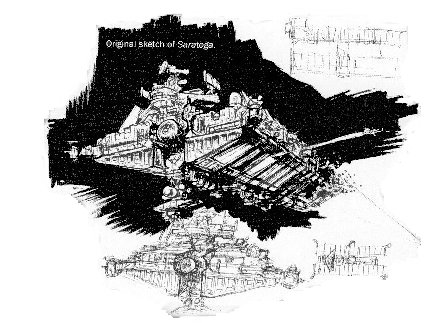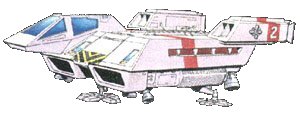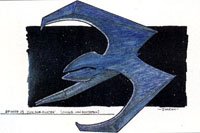Bernard Hides and his team created the production design of Space's futurewar
When production designer Bernard Hides was hired for the pilot of Space: Above and Beyond, he was surprised to find out why he got the job.
Says Hides, "I didn't realize it at the time, but what they were looking at was a number of war movies I'd done."
Hides has re-created World War I (The Lighthorsemen), World War II (Farewell to the King, Prisoners of the Sun) and the Vietnam War (Casualties of War). Now, he adds the Chig/Earth War to his battle-scarred resume.

"When I came in, they'd already established the alien spaceship design and a design for the alien," says Hides. His first order of business, then, would be to create the look for the heroic Earth military force, one that would be grounded in World War II designs. But Hides kept looking at the alien drawings - a distinctly non-human, elephantine creature and called a time-out.
"I'd done a miniseries, The Tommyknockers, and we had a tremendous, spectacular-looking alien, but it had problems," he says. "It needed three men to look after it, it had to be rigged-up on wires so it could walk, and it was a big production number to get it right."
Hides gently broke it to the producers, "The alien has got to be a man in a suit. That is, in order to make it work-if you want it to run, to walk, to lump, and if you want to have more than one of them."
Everyone reluctantly agreed, and Hides started on new concepts for the Chigs, adding them to the mix of Earth military designs he was already juggling. "I had six weeks to get the production up and running," he remembers. "I left for Australia, where the pilot was shot, expecting to find a crew there waiting for me. I got there, and nobody had been hired. I had to get a crew of draftsmen, graphic artists construction people, model makers and plaster people together all in about a week. It was very hectic, and then it got worse."
Hides and his team, working in concert with executive producers Glen Morgan and James Wong, as well as the special effects artists at Area 51, had to create the look of two dis tinct worlds-the Earth of 2063, and the alien Chigs. Here's how they did it:
E A R T H F O R C E S
THE SARATOGA
"I saw it as an aircraft carrier," says Hides. "It has a feeling of bulkiness with a modular design. Each of the modules carries six aircraft, each one's a hangar and you could have as many modules as you wanted. The components would be built on Earth and then assembled in space. We really wanted the rivets showing. It implies that this is made out of huge pieces of metal.
"The feeling of the flight deck, with the cockpits for the fighters coming up, I equate that activity to the Grand Prix, with the pit crews servicing the racers. We wanted to see the pilots on the flight deck of the Saratoga, but we couldn't build six Hammerheads. It's a huge aircraft, and it takes up a lot of space. So we came up with the concept of having the fighters underneath, and the cockpit drops down below the flight deck and links up with the fighter body.
"We wanted the interior to have a cramped kind of feeling, with narrow passageways, like the decks of an aircraft carrier."
HAMMERHEAD FIGHTERS
 This design pre-dated
Hides's involvement with the production. Area 51 would create all the
battle scenes using the fighters, but Hides's team did have to construct
cockpits for the Saratoga flight-deck set. Once the final look for the
Hammerhead was established, one full-sized fighter was built for the
two-hour pilot.
This design pre-dated
Hides's involvement with the production. Area 51 would create all the
battle scenes using the fighters, but Hides's team did have to construct
cockpits for the Saratoga flight-deck set. Once the final look for the
Hammerhead was established, one full-sized fighter was built for the
two-hour pilot. "We built it in Australia, and rebuilt it in LA," says Hides. "It took eight weeks to get here, so it wasn't ready for episode one, but we did get it for episode two."
In addition to the Earth military designs in the series, Hides and his designers have extrapolated an entire fleet of attack jets, sub-orbital vehicles and land craft, all ready to be written into future adventures. "We've never seen these," he says. "But we can deploy any of them at any time."
GRAPHIC DESIGN
 "Graphics tell a little story,
whether it's a stencil on a pipe or a patch on a uniform," says Hides. "The
extensive graphics seen in the series create the impression that a complex
military bureaucracy is hard at work. The military's motto is, if it's moving,
salute it, if it's not, put a sign on it."
"Graphics tell a little story,
whether it's a stencil on a pipe or a patch on a uniform," says Hides. "The
extensive graphics seen in the series create the impression that a complex
military bureaucracy is hard at work. The military's motto is, if it's moving,
salute it, if it's not, put a sign on it." Artist Geoffrey Mendel created the show's vibrant graphics. "The producers' design aesthetic is World War II," says Mendel. "When they say that the series is set in 2064,1 see it at 1964. So I kind of do an early'60s, late-'50s military design. My main influence is the 1964 New York World's Fair. The typefaces used, especially, are very much inspired by that.
"Glen and Jim have said they're not really interested in doing science fiction, they're interested in doing World War II, and indeed that's what they're doing," adds Mendel.
But the artist, himself a science fiction fan, was interested in establishing a tight continuity for the series, right down to completing designs and blueprints for the Saratoga, most of which will never be seen anywhere in series episodes.
"I'm kind of doing for Space what guys like Michael Okuda have done for Star Trek," he says. "I'm just thinking about the fans, being a fan myself."
THE SILICATES
"We decided it would be like Mad Max, where everything was sort of falling apart," says Hides, "We're saying these are robots who don't really care what they look like. So we had clothing that was falling apart and wires showing through their skin. We found that it's cheaper to show these small areas on their faces, for instance, than to go for biomechanical arms or sdmething."
T H E C H I G S
TECHNOLOGY
"We decided on using a hexagon, a six-sided figure, as the building block for the alien designs," says Hides. "We developed a cuneiform style of writing which is always depicted in a hexagon."
The first glimpse viewers got into Chig physiology was of an alien soldier's hand, made up of five claw-like digits, two of which were fused together. The Chigs, then, manipulated objects with these three digits and an opposable thumb-like appendage.
 This three-pronged
design was carried over into all of the Chig technology, says Hides.
Variations of it occurred in their fighters [including Chiggy von Richtofen's
souped-up version], as well as their bombers, destroyers, motherships,
tanks, and the Chig ambassador ship filmed for episode 21. The Chigs'
battle suits were taken from Earth history. "The brief was, let's make
it like a suit of armor from medieval times, with a great helmet," says
Hides. "They wanted it to be very mechanical, like a suit of armor,
but also like a pressure suit. There's a self-destruct in their suits.
As soon as the integrity of the uniform is broken, they destroy themselves,
so no one can see what the body looks like."
This three-pronged
design was carried over into all of the Chig technology, says Hides.
Variations of it occurred in their fighters [including Chiggy von Richtofen's
souped-up version], as well as their bombers, destroyers, motherships,
tanks, and the Chig ambassador ship filmed for episode 21. The Chigs'
battle suits were taken from Earth history. "The brief was, let's make
it like a suit of armor from medieval times, with a great helmet," says
Hides. "They wanted it to be very mechanical, like a suit of armor,
but also like a pressure suit. There's a self-destruct in their suits.
As soon as the integrity of the uniform is broken, they destroy themselves,
so no one can see what the body looks like." PHYSIOLOGY
What's inside that Chig armor is revealed in the season's final installments, held back by Fox from their original May airdates.
"We decided that they see very badly, so they do a lot of things with touch," he says. "They're very sensuous. If you look at the alien, it's got black eyes and very little ears, just holes, really."
Decisions about the aliens' physiology came in stages as the season progressed. As already noted, the Chigs' hand was designed first. "If you notice, he's got pads on his hand, and the knuckles have large, raised areas, like cartilage, so they may occasionally walk along the ground dragging the back of their hands," says Hides.
 This led to further discussions about an overall look for the aliens' bodies.
"We had a lot of meetings, and we first asked, 'When he comes out of the
uniform, is he naked?' We came up with about a dozen sketches of a bunch
of naked aliens, but I convinced [Glen and Jim] that it would be better
if they had some kind of clothing, a simple robe or toga or something to
cover the body. Then we'd just have to make the hands and the head. It would
be cheaper.
This led to further discussions about an overall look for the aliens' bodies.
"We had a lot of meetings, and we first asked, 'When he comes out of the
uniform, is he naked?' We came up with about a dozen sketches of a bunch
of naked aliens, but I convinced [Glen and Jim] that it would be better
if they had some kind of clothing, a simple robe or toga or something to
cover the body. Then we'd just have to make the hands and the head. It would
be cheaper. "George Suhayda, my sketch artist, and I came up with half-a-dozen varieties of bodies, and showed them to Jim and Glen. They chose an overall direction, but they also picked little pieces out from each sketch that they liked, and George took those and started again, refining the look.
"We then made some crude sculptural heads, but by then we were running out of time, so we took a week and made a plasticine model with all the elements we had discussed. With the mask, we really focused on the eyes, since that's the most emotionally expressive part of the human face, and we said, 'Let's retain that.' We used radio-control pieces on the lips, so the facial expressions are controlled by two or three handlers.
"It was an evolutionary process. The body's very gaunt, and you see some of its internal organs are external. It's really hunched over. You see that it scampers along, ape-like.
"So all those things we planned 22 weeks ago, not knowing where we were heading, actually all came together."
All site graphics, original texts, and content other than specified © DrkNite. Fan art, fan photos, and other contributed materials © to their respective owners. All rights reserved.